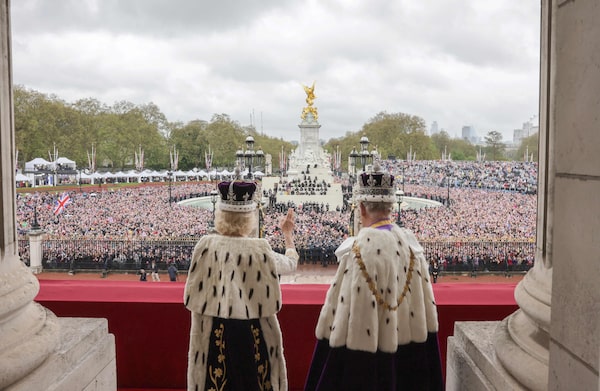
Britain's Queen Camilla and Britain's King Charles III stand on the balcony of Buckingham Palace, following their Coronation Ceremony, in central London.CHRIS JACKSON/AFP/Getty Images
John Fraser is the founding president of the Institute for the Study of the Crown in Canada and the author of The Secret of the Crown and Funeral For A Queen: Twelve Days in London.
The coronation party is almost over. King Edward’s crown, the golden orb and bejewelled sceptre will all be on display in Westminster Abbey for a few days this week for the price of a ticket, and then it’s back to their display cases at the Tower of London, not to be used again until the next king or queen is crowned. Their current holder – Charles III, King of Canada and his other realms – can now get on with the business of being the leader he’s been preparing to be since he became the direct heir to the throne at the age of 4 – 70 years ago. How he goes about it will fashion the verdict on his reign.
Already, thanks to his remarkable coronation on Saturday, we know something that will be worth sustained scrutiny in the days ahead: His reign will feature more diversity than this particular monarchy has seen in its thousand years’ history. Nor will it be a reign frightened of innovation, for better or worse. And in Canada, at least, it may finally be able to further remind us all of promises still to be kept that were made to Indigenous leaders for over 300 years of a challenged relationship.
Throughout the lead-up to the big day on Saturday, King Charles went out of his way to meet Indigenous leaders from Canada and his other realms, including special audiences for Governor-General Mary Simon and leaders from the Assembly of First Nations, Inuit and Métis, as well as Indigenous leaders from Australia and New Zealand.
On Sunday morning the former national chief of the Assembly of First Nations, Perry Bellegarde, a personal friend of King Charles, was invited to address the royal household at the first post-Coronation morning service at the Chapel Royal at St. James’s Palace. It was the first visit of an Indigenous leader to the Palace since the 1710 delegation of Mohawk and Iroquois leaders to the court of Queen Anne.
For Canadian observers during the lead-up, the attention paid to Indigenous diversity was the most arresting sign of great changes from the monarchy of the past, but there were plenty of other innovations in the business of the Saturday coronation service itself that were worth noting:
- The first time a boy of 14 got a chance to start off the whole proceedings by greeting the King and more or less asking him if he was ready to rule.
- The first time persons of colour were featured in all roles, from clergy on through, and the first time female bishops and choristers participated.
- The first time leaders of other faiths were not just welcomed into the Abbey but were also given a special greeting by the sovereign.
- The first time the governors-general of the King’s realms were not only invited to attend but were similarly acknowledged and greeted.
- The first time a gospel choir was ever heard.
- The first time a Hindu prime minister read a lesson from a Christian Bible.
- The first time a Sikh tenor was in the choir stalls.
- And I suppose it should also be noted, this was the first time a queen has been crowned to a divorced king since Henry VIII’s second bride, Anne Boleyn, managed the deed in 1533. True, she lost her head less than three years later, but in this instance that is merely a detail.
King Charles’s own panoply of complex family relations was also on display. There’s a debate already going on in some circles in London about whether it was by design that Princess Anne’s cockaded hat with large red plume was conspicuously placed to effectively obscure all televised views of Prince Harry. And no one was ever quite sure where the disgraced Prince Andrew was tucked away.
The one big snafu in all the preparations was the ill-advised idea that everyone at home could say the oath of allegiance along with the Abbey crowd. This was not King Charles’s dumb idea but that of Justin Welby, the presiding Archbishop of Canterbury. He certainly got the message in time, however, and a grateful nation learned it wasn’t an order but merely an “invitation.”
Over at Canada House, there was a considerable gathering of Canadians to watch the coronation on large television monitors, a gathering which included many Indigenous visitors. A witness to the proceedings, verified by another person present, reported that the most striking thing to happen during the live broadcast of the service was when the King was crowned and later during the playing and singing of God Save the King, Indigenous members in the gathering all stood in respect. Most of the non-Indigenous viewers stayed glued to their seats.
This suggests interesting days to come in the story of Canada, especially when the King and Queen make their next visit.